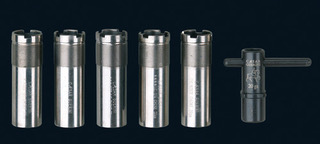This is a topic that I normally try to avoid like the plague. Why? Quite frankly, it’s because everyone and I mean EVERYONE has a fairly staunch opinion on the topic. I’ve actually walked into the clubhouse at the course, stumbling into a heated debate among clay shooters about choke tubes and what does and doesn’t work and I’ve just as quickly turned around to exit the building.
Chokes are a necessary part of any shooter’s equipment. Regardless of whether you’re shooting clay or feathers, you will need to, at some point be proficient in understanding the subtle nuances of changing out chokes, dependent on the presentation. Let’s take a quick look at what exactly is a choke tube.
The first choke, a fixed choke, was patented in 1866 with the 1st interchangeable system not hitting the scene until 1969 with the WinChoke system from Winchester. A choke tube is utilized to either expand or constrict the flow of shot out of the muzzle of a shotgun. Keep in mind that this restriction or expansion is in ten thousandths of an inch.
So, with such a minuscule measurement, how in the world can that possibly assist your shooting on the clay course or the hunt field? Simple. Ballistics, controlled by physics and geometry is a powerful thing, even in tiny increments. My own hubby Mike is experimenting with chokes for field trials.
When you must drop birds quickly and as close as possible so the retrieves are lightning fast, and you can’t mutilate the bird, you have to create the perfect balance.
Mike has opted for a skeet choke for his Fabarm L4S 12ga shooting a Fiocchi 1 1/4oz 1330fps #8. This combination has proven deadly for quail all the way up to pheasant while keeping the breast meat intact.
Previously, he was using an improved cylinder and 1 1/8oz 1200fps shell. While we do have some fun video of him “poofing” the birds, the final result was either a close shot that led to a 10pt deduction for a mutilated bird or a farther shot that ended with either a lost bird or a long retrieve. Both detrimental to the final score.
He’s ultimately purchasing a spreader choke specifically for the shoot to retrieve game we play so that he can obtain the best results for field trialing.
Typically, I will set up over/unders with modified in the top and improved cylinder in the bottom. This is the standard issued set up with a very good reason. It will allow the shooter to easily tackle the average presentations on the course and hunt field. I will often swap between my barrels depending on the presentation. If I have an incoming clay inside of 20yds, I will absolutely set up my bottom barrel (improved cylinder) to fire first. For those farther out birds or rabbits, I let the top barrel (modified) handle the job.
For an autoloader, it depends on the manufacturer. More often than not, I will put in a modified as I’m not inclined to physically change out chokes while shooting the course. Instead, I will pop in a different shot shell and allow the ballistics of the load handle the differentiation in pattern.
With this in mind, you may want to play around with the shot size that you use. Most shooters like #7.5 shot for clay rabbits since the clay itself is so much thicker and requires more umph to break it. When shooting closer shots then a #9 shot size is a great choice as it puts a thicker pattern into the air. My go to is always a #8 though. It seems to handle the majority of the presentations with no problem.
No matter what choke or shot you select, you need to pattern it. Not all guns like to shoot all ammo. When you pattern, keep it realistic to the application. If you are shooting trap, then pattern at 16yds and 27yds. For skeet, pattern at 20yds and for sporting clays pattern at 30yds. Remember not all guns are built the same with some muzzles throwing a rounded pattern and some an oval pattern. This goes the same for all those aftermarket choke tubes. When you pattern, you are looking for about 70% of the load within a 30” circle showing minimal holes.
So, what’s your favorite choke/shot size combination and application? Just remember, keep that muzzle smooth and slow your swing and you’ll be amazed at how fast you can take down birds. Be sure to share the sport with a friend or family member and help grow this fantastic sport.
Kate Ahnstrom, owner of Virginia Shooting Sports is a certified, professional instructor of the Paragon School of Sporting, pro staff Syren/Caesar Guerini, resident pro Orapax Hunting Preserve, Artemis ambassador for Va, and field staff member of the Sisterhood of the Outdoors. Her tireless dedication to her students’ success is obvious in each and every lesson.
tireless dedication to her students’ success is obvious in each and every lesson.



